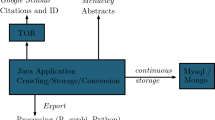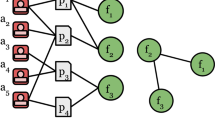Abstract
The paper introduces a concept for measuring the interpretive fragmentation of scientific fields by the analysis of their citation networks. Transitive closure in two-mode networks is the basis of the proposed measurement. To test the validity of the concept two analyses are presented. One compares the integrity of two social sciences, sociology and economics, and a natural science, biophysics. The results are in line with the widely held opinion, that because of the lack in cumulative and consensual knowledge production mechanisms the social sciences are more disintegrated. Sociology is considerably more fragmented then economics, as the different paradigm structure of these disciplines would predict. As a second test, the fragmentation of scholarly communication inside and between the sub-fields of sociology is measured. The results correctly indicate that meaning making processes are taking place inside invisible colleges.



Similar content being viewed by others
Notes
Leahey and Moody (2007).
“Core journals are published by sociological associations, groups, faculties, and institutions, and/or have the term ≪sociology≫ in their titles. All substantive articles appearing in these journals are abstracted and indexed, and citations are provided to the book reviews published therein.” Source: http://www.csa.com/factsheets/socioabs-set-c.php, downloaded 10-20-2009.
That is, the line weights were divided by the degree of the article (the number of bibliographical couplings an article has).
This idea is based on the same assumptions as the concept of the ambiguity of citations with a large semantic diameter.
References
Abbott, A. (2001). Chaos of disciplines. Chicago: University Of Chicago Press.
Batagelj, V., & Mrvar, A. (1998). PAJEK—program for large network analysis. http://citeseerx.ist.psu.edu/viewdoc/summary?doi=10.1.1.27.9156. Accessed 25 October 2010.
Blondel, V. D., Guillaume, J., Lambiotte, R., & Lefebvre, E. (2008). Fast unfolding of communities in large networks. Journal of Statistical Mechanics: Theroy and Experiment. doi:10.1088/1742-5468/2008/10/P10008 http://sites.google.com/site/findcommunities/. Accessed 25 October 2010.
Bockman, J., & Eyal, G. (2002). Eastern Europe as a laboratory for economic knowledge: The transnational roots of neoliberalism. The American Journal of Sociology, 108(2), 310–352.
Breiger, R. L. (1974). The duality of persons and groups. Social Forces, 53(2), 181–190.
Cole, S. (2001a). What’s wrong with sociology? New Brunswick & London: Transaction Publishers.
Cole, S. (2001b). Why sociology doesn’t make progress like the natural sciences. In S. Cole (Ed.), What’s wrong with sociology? (pp. 37–60) New Brunswick & London: Transaction Publishers.
Davis, J. B. (2008). The turn in recent economics and return of orthodoxy. Cambridge Journal of Economics, 32(3), 349–366.
Egghe, L., & Rousseau, R. (2003). A measure for the cohesion of weighted networks. Journal of the American Society for Information Science and Technology, 54(3), 193–202. doi:10.1002/asi.10155.
Fourcade, M. (2006). The construction of a global profession: The transnationalization of economics. The American Journal of Sociology, 112(1), 145–194.
Frigotto, L. & Riccaboni, M. (2010). A few special cases: Scientific creativity and network dynamics in the field of rare diseases. Proceedings from Sunbelt XXX. Riva del Garda Fierecongressi. Italy: Trento.
Fuchs, S. (2001). What makes sciences ‘Scientific’. In J. S. Turner (Ed.), Handbook of sociological theory. New York: Springer.
Gouldner, A. W. (1970). The coming crisis of Western sociology. New York: Basic Books.
Kuhn, T. S. (1996). The structure of scientific revolutions. Chicago: University of Chicago Press.
Leahey, E., & Moody J. (2007). Sociological Innovation through Subfield Integration. Paper presented at the annual meeting of the American Sociological Association, New York. 10 August, Manuscript http://www.allacademic.com/meta/p_mla_apa_research_citation/1/8/4/1/1/p184115_index.html. Accessed 25 October 2010.
Leydesdorff, L. (2001). The challenge of scientometrics: The development, measurement, and self-organization of scientific communications. Parkland: Universal Publishers.
Moody, J., & Light, R. (2006). A view from above: The evolving sociological landscape. The American Sociologist, 37(2), 67–86. doi:10.1007/s12108-006-1006-8.
Opsahl, T. (2009). Structure and evolution of weighted networks. http://opsahl.co.uk/tnet/content/view/15/27/. Accessed 25 October 2010.
Porter, A. L., Roessner, J. D., Cohen, A. S., & Perreault, M. (2006). Interdiscipinary research: Meaning, metrics and nurture. Research Evaulation, 15(3), 187–195.
Rafols, I., & Meyer, M. (2009). Diversity and network coherence as indicators of interdisciplinarity: Case studies in bionanoscience. Scientometrics, 82(2), 263–287. doi:10.1007/s11192-009-0041-y.
Small, H. G. (1978). Cited documents as concept symbols. Social Studies of Science, 8(3), 327–340. doi:10.1177/030631277800800305.
Stinchcombe, A. (2001). Disintegrated disciplines and the future of sociology. In S. Cole (Ed.), What’s wrong with sociology? (pp. 37–60) New Brunswick & London: Transaction Publishers.
Turner, S. P., & Turner, J. H. (1990). The impossible science: An institutional analysis of American sociology. Newbury: Sage.
Wernicke, S., & Rasche, F. (2006). FANMOD: A tool for fast network motif detection. Bioinformatics (Oxford, England), 22(9), 1152–1153. doi:10.1093/bioinformatics/btl038. http://theinf1.informatik.uni-jena.de/~wernicke/motifs/index.html. Accessed 25 October 2010.
White, H. C. (2008). Identity and control: How social formations emerge (2nd ed.). Princetion: Princeton University Press.
Acknowledgments
I thank Róbert Tardos, Balázs Vedres, Vladimir Batagelj, Andrew Abbott, Erzsébet Forczek, Attila Gulyás, László Barabási, Zoltán Kmetty and the participants of the 9th EUSOC seminar and XIX SUNBELT for their ideas, help and suggestions. This work was supported in part by the program “Increasing the Innovational, Research and Development Output of the Corvinus University of Budapest by the Establishment of Five Interdisciplinary Centres of Excellence”/TÁMOP-4.2.1/B-09/1/KMR-2010-0005.
Author information
Authors and Affiliations
Corresponding author
Appendix: Clustering methodology
Appendix: Clustering methodology
For the purpose of clustering of the bibliographical coupling network modularity optimization algorithm of Blondel et al. (2008) was used. This method hierarchically clusters all previous cluster structures by integrating nodes in the same cluster. This made it possible to develop a two-level solution for the sub-disciplinary structure. This feature of the algorithm is important, because in this way the inherent dual structure of disciplines (invisible colleges and research topics) can be revealed. The results on the raw network were not satisfactory: the distribution of the clusters was too skewed (the ratio of the first and second largest clusters was around two).
In order to gain a detailed picture of the network communities some transformations were implemented. First, the line weights were normalized; it in other words, the proportional strength of ties was calculated.Footnote 4 In this way all nodes of the network have a strength (sum of line weights) of one. The algorithm yielded a clustering solution on this network with a modularity index of 0.406 at the first clustering step. The distribution of the cluster sizes were skewed because just 24 clusters from the resulting 220 were over 10. This means that the discursive fields below the specialties and paradigms were unobservable. At a second sequence of transformations an attempt was made to find the firm structure behind this abstract clustering. The weaker ties were successively removed between articles. This approach was based on the assumption that strong ties resulting from normalization are more clustered, and that weak ties are not so important or are caused by perfunctory citations.Footnote 5
With this method the degree distribution also became less unequal; this fact also indicated the likelihood of a more balanced cluster distribution. To test the assumption that removing weak ties calculated by normalization results in a more clustered network, clustering coefficients were computed. These coefficients were computed above a given normalized line weight in a consecutive way. The coefficients were decreased as the line weights increased. The higher the line weights were, obviously the lesser the number of ties were in the network. However, these lessening ties connected the whole network together, because the network remained as one big component. Random networks were generated in order to make the clustering coefficients of each network comparable. 100 random networks with the same degree distribution were generated for each. The ratio of the clustering coefficients of the random and the real networks clearly indicates that the stronger the ties are, the more clustered patterns they form (Fig. 4).
The weakest 90% percent of all the bibliographical couplings were removed. On this network the clustering algorithm resulted in a two-step solution with the highest modularity index in the second step 0.553. The cluster structure which resulted from the second clustering step was used in the analysis. The second cluster structure represents the sub-fields or invisible colleges of Sociology (Table 4).
Rights and permissions
About this article
Cite this article
Varga, A.V. Measuring the semantic integrity of scientific fields: a method and a study of sociology, economics and biophysics. Scientometrics 88, 163–177 (2011). https://doi.org/10.1007/s11192-011-0342-9
Received:
Published:
Issue Date:
DOI: https://doi.org/10.1007/s11192-011-0342-9





